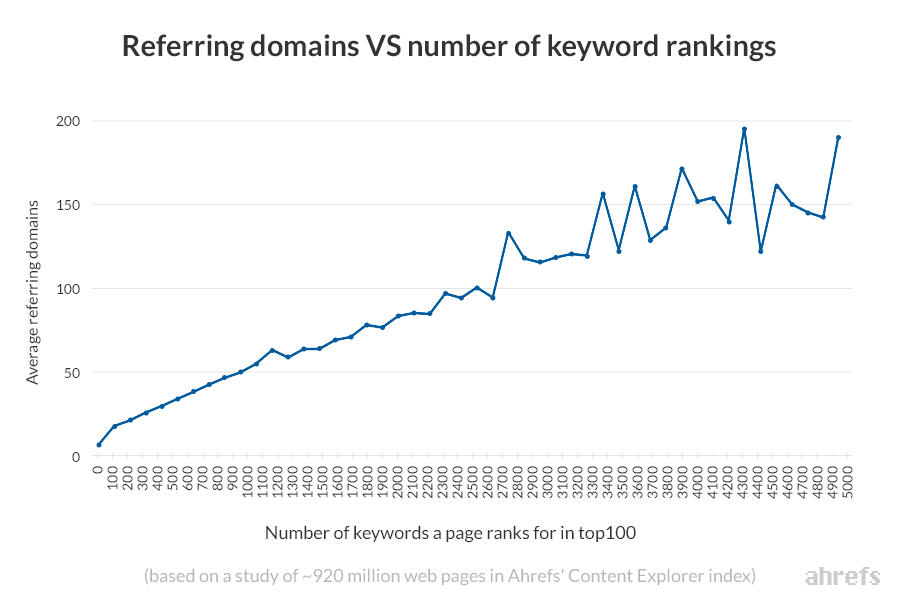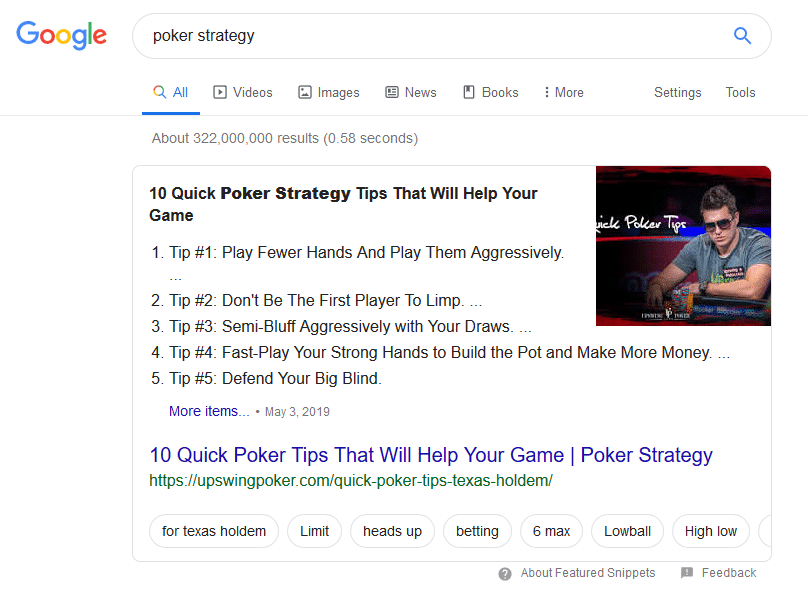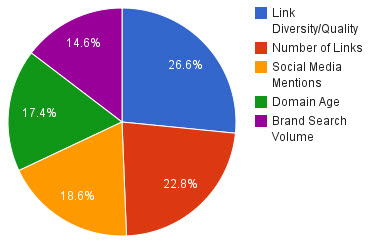
Did you know Google’s algorithm is suspected to weigh more than 200 factors when determining page rankings?
We’re not going to go over all 200+ of those factors today. Not only because Brian from Backlinko has already covered them, but also because most of them are relatively inconsequential and not worth worrying about when you’re creating content.
Today you’re going to learn about the 8 factors that really move the needle when it comes to organic search traffic:
Let’s get down to the nitty-gritty.
The number of unique domains that link to your site is one of the most important ranking factors in Google’s algorithm. Check out the obvious correlation between referring domains pointing to a page and its rankings (according to an Ahrefs study of 920 million web pages):

In their study, Ahrefs was quick to remind us that correlation does not imply causation, and thus this graph is not direct evidence that acquiring more referring domains will help you rank in Google. That said, almost every SEO expert would agree that it’s extremely difficult to reach the top 10 Google search results for a keyword if the competition has a massive number of backlinks.
Quantity isn’t everything when it comes to the effectiveness referring domains. The referring page’s authority and your website’s link velocity also play a role in rankings.
This quote directly from Google’s Steps to a Google-friendly site page sums up the importance of a referring page’s authority (particularly the second sentence):
Google interprets a link from page A to page B as a vote by page A for page B. Votes cast by pages that are themselves “important” weigh more heavily and help to make other pages “important.” (emphasis added)
In other words, links are more valuable when they come from an authoritative site. For example, a link from the Wall Street Journal would have a greater impact on your rankings than a link from your aunt Lydia’s new blog about cats.
Link velocity is essentially the rate at which a website acquires links. Your site’s link velocity needs to look natural, as if the links were acquired organically.
You do not want your site to have a consistent link velocity because Google could see it as unnatural link building. Think about it: would an authoritative site receive a very similar number of links every day/week/month? Absolutely not.
A consistent link velocity can not only reduce the effectiveness of your links, it can also lead to a penalty that decimates your page’s search traffic. Search engines hate when people try to game their algorithm.
How your visitors behave after landing on one of your pages can have a significant impact on your rankings.
Professional SEOs suspect that Google’s A.I. looks at many user-based signals to better rankings, including seemingly random and unimportant ones (like how many Chrome users bookmarked the page).
Random factors aside, there are three user-based signals in particular that have a strong correlation to a page’s rankings:
Clickthrough rate (CTR) is the percentage of searchers who click on your page after it appears in the search results. The simple formula is:
Clicks ÷ Impressions = CTR
To attain a high CTR, you need to write a top notch meta title and meta description. You may also want to implement scheme for certain types of pages, such as recipes or reviews.
For example, take a look at the difference between these two results for “honey chicken recipe”:

The top result has a star rating, a descriptive title/description, and a thumbnail image of the final product, while the bottom result is quite plain. It’s obvious which of these two results would have a higher CTR.
Bounce rate is the percentage of visitors to a website who leave after viewing only one page. Some SEOs would disagree that bounce rate impacts rankings, but there have been studies (like this one by SEMRush) that have found a correlation.
Pogosticking is a special type of bounce in which the visitor goes back to the search results and clicks a different page. When a visitor bounces in this way, it means your page didn’t satisfy their query, so they had to try another result.
To improve your site’s bounce/pogosticking rate, you need to do a better job satisfying searcher intent (more on that later). Improving certain on-page factors such as site speed and readability can also have an impact.
Dwell time is how long a visitor stays on your website after arriving. Google’s algorithm loves looking at dwell time when ranking pages because a high dwell time typically means the user likes what they found.
In late 2016, mobile devices passed desktops in worldwide internet usage for the first time. Since then, mobile has extended its lead. This underscores the importance of ensuring your site is mobile-friendly.
Late 2016 is also when Google implemented mobile-first indexing. This means Google is pulling results from mobile-optimized sites before sites that are geared towards desktops.
Here are a few things to look at regarding your site’s mobile optimization (credit to OptinMonster for this list):
For more on mobile SEO, read Backlinko’s behemoth guide to mobile SEO.
Your on-page SEO encompasses all of the factors on your website that you can optimize, such as the site speed or title tags. Let’s quickly run through the most notable on-page factors.
Although not as important as it once was, including your target keyword(s) in certain areas of your content remains an important signal. These areas include:
You may be surprised to not see meta description or URL slug on this list. However, Google hasn’t used meta descriptions when ranking pages in many years. And this quote from Google’s John Mueller speaks to the unimportance of keywords in your URL:
I believe that is a very small ranking factor. So it is not something I’d really try to force. And it is not something I’d say it is even worth your effort to restructure your site just so you can get keywords in your URL.
That said, you should still probably include keywords in your meta description and URL in order to better describe the page. Google may not look at them when deciding who wins the rankings battle, but they can indirectly impact your rankings by improving clickthrough rate and anchor text distribution.
Google likely uses a sophisticated version of TF-IDF, which stands for term frequency — inverse document frequency. That’s a fancy way of saying “how often does a particular word appear in a document?”
In layman’s terms, Google wants to see related concepts that make sense to include given the keyword/topic. Google does this to try to understand which page provides the most significant depth so they can serve those results first.
For example, suppose you want to write a complete guide to buying a car. There are several topics that Google (and your readers) will expect to see included, such as:
Other topics you may want to include that would likely appear less often than the topics above include:
Google looks at all pages currently ranking for the main topic — in this case “buying a car” — and calculates how often each of the above terms should be included in comparison to all of the other terms. If you included all or most of the topics Google expected to see, your page has a better chance to rank.
Page speed has been considered one of the main SEO ranking factors for a long time. Google wants searchers to have a good experience on the web, and slow-loading pages are a hindrance to that goal.
Structured data refers to implementing some type of markup to your page. This markup provides additional details about the page to Google.
If you add structured data to a page, your result in the search engines might change. We went over an example of a recipe page’s structured data in the clickthrough rate section above, but there are many other types of structured data, including:
In all cases, adding structured data means your search results will include more details., and it can even help you reach the coveted “featured snippet” spot for a keyword (example from Upswing Poker pictured below).

Readability refers to how easy your content is to read. You can test your readability using built-in tools like Yoast or by copy-pasting your content into a tool like this.
For tips on how to make your content more readable, read this guide from Yoast.
Pages with more words tend to rank better than pages with fewer words. That said, it’s important to tailor your word count to your topic. If your topic is simple enough to be covered in a short 500 word article, for example, you probably shouldn’t write a 2500 word article.
It’s a good idea to check out your competition when deciding on your word count. If they all wrote 2000 words, you should aim to write around the same (or maybe a little more).
Domain authority is a metric that was developed by the SEO geniuses over at Moz, so let’s start with their definition:
Domain Authority (DA) is a search engine ranking score developed by Moz that predicts how well a website will rank on search engine result pages (SERPs). A Domain Authority score ranges from one to 100, with higher scores corresponding to a greater ability to rank.
The 100-point scale for scoring domain authority is logarithmic, meaning your score gets tougher to improve as it gets higher. For example, it’s much easier to grow your score from 5 to 10 than it is grow from 45 to 50.
DA is calculated based on a number of factors, including referring domains and total backlinks. Like Google, Moz isn’t forthcoming about the many factors weighed in their algorithm, but this graph from SEO Siren is probably a good estimate of what impacts DA:

Having a high DA score is great, but attaining one shouldn’t be your only goal. Your main goal should be to attain a higher DA than your SEO competition. Here’s a quote about this straight from Moz:
It’s best used as a comparative metric (rather than an absolute, concrete score) when doing research in the search results and determining which sites may have more powerful/important link profiles than others.
Because it’s a comparative tool, there isn’t necessarily a “good” or “bad” Domain Authority score.
Remember, domain authority is merely a predictor of a site’s ability to rank, which is why a high domain authority correlates to better rankings. It is not weighed by Google’s algorithm.
E.A.T is an acronym that’s been floating around the SEO universe for a while, but it recently became more important after Google’s August 2018 algorithm update.
Expertise is not just about being knowledgeable in your space. You also have to be able to communicate your knowledge in a way that engages people. You have to know what your audience wants and how to efficiently present the information you’re offering.
How can you create content that displays a high level of expertise? Here are a few tips from Moz:
Authority measures how well your brand/site stacks up against your competition. You are an authority in your niche when other experts cite you as their source of information, or when your brand/site becomes synonymous with the relevant topics.
Trustworthiness is determined by the sentiment associated with your brand/site. If you receive a notable number of complaints or bad reviews and fail to address them, your rankings can take a nose dive. On the other hand, positive reviews on places like Yelp, Facebook, and especially the Better Business Bureau will improve your trustworthiness (and possibly your rankings as well).
Here’s another list of tips from Moz with ways to promote trustworthiness:
E.A.T. is a framework every website should follow when making content, but it’s especially important if your site is what Google calls a “YMYL site”.
YMYL stands for “Your Money or Your Life” and refers to sites that make content around health, financial issues, and safety. Google really doesn’t want searchers to land on low quality results with incorrect information when it could negatively impact their happiness, health, or wealth.
To avoid negatively impacting searchers’ well-being, Google raised the bar for YMYL sites in their August 2018 algorithm update. Now, you need a site that displays a high level of expertise, authority, and trust to rank for keywords related to health, finance, and safety.
Expertise, authority, and trust take time and effort to build, and there is no shortcut around that. All you can do is focus on making great content and settle in for the long haul.
For some quick tips on improving your site’s E.A.T. rating, read this article from searchenginejournal.
High quality content ranks better than low quality content, but what makes content “high quality”?
Here’s some helpful guidelines straight from Google:
Basic principles
- Make pages primarily for users, not for search engines.
- Don’t deceive your users.
- Avoid tricks intended to improve search engine rankings. A good rule of thumb is whether you’d feel comfortable explaining what you’ve done to a website that competes with you, or to a Google employee. Another useful test is to ask, “Does this help my users? Would I do this if search engines didn’t exist?”
- Think about what makes your website unique, valuable, or engaging. Make your website stand out from others in your field.
Specific guidelines
Avoid the following techniques:
- Automatically generated content
- Participating in link schemes
- Creating pages with little or no original content
- Cloaking
- Sneaky redirects
- Hidden text or links
- Doorway pages
- Scraped content
- Participating in affiliate programs without adding sufficient value
- Loading pages with irrelevant keywords
- Creating pages with malicious behavior, such as phishing or installing viruses, trojans, or other badware
- Abusing rich snippets markup
- Sending automated queries to Google
Follow good practices like these:
- Monitoring your site for hacking and removing hacked content as soon as it appears
- Preventing and removing user-generated spam on your site
You may have noticed that most of these tips cover what not to do, so let’s take a look at a section from Google’s Webmaster Academy course on creating valuable content:
As you begin creating content, make sure your website is:
Useful and informative: If you’re launching a site for a restaurant, you can include the location, hours of operation, contact information, menu and a blog to share upcoming events.
More valuable and useful than other sites: If you write about how to train a dog, make sure your article provides more value or a different perspective than the numerous articles on the web on dog training.
Credible: Show your site’s credibility by using original research, citations, links, reviews and testimonials. An author biography or testimonials from real customers can help boost your site’s trustworthiness and reputation.
High-quality: Your site’s content should be unique, specific and high-quality. It should not be mass-produced or outsourced on a large number of other sites. Keep in mind that your content should be created primarily to give visitors a good user experience, not to rank well in search engines.
Engaging: Bring color and life to your site by adding images of your products, your team or yourself. Make sure visitors are not distracted by spelling, stylistic and factual errors. An excessive number of ads can also be distracting for visitors. Engage visitors by interacting with them through regular updates, comment boxes or social media widgets.
If you need some inspiration for how to make your content useful, valuable, credible, high-quality, and engaging, we recommend browsing successful blogs in competitive niches, like Ahrefs or Copyblogger. (Quick tip: to find successful blogs, simply search for a valuable and competitive keyword on Google and look at the top results.)
Many people rely on their intuition when creating content that will target a specific keyword. These people are oftentimes experts on the topic, so they’ll intuitively know what searchers want to see, right?
Wrong.
You could follow all of the factors above to the letter, but you’ll never rank for competitive keywords without satisfying the searcher’s intent. We really like Ahrefs’ definition of searcher intent:
Search intent is the why behind a search query. In other words, why did the person make this search? Do they want to learn something? Are they looking to make a purchase? Or, are they looking for a particular website?
Rather than relying on your intuition when planning your content, you should rely on Google.
To identify the searcher intent of a keyword, simply type it into Google. Make sure you use a private/incognito window, otherwise Google might give you different results based on your search history and behavior.
When you search for “surfing in san diego”, for example, the top 5 results are all lists of the best places to surf in San Diego:

By looking at these results, you would be correct to conclude that the most effective way to target this keyword is to write your own list of the best places to surf in San Diego. You should also open every result on the front page to see exactly what they’ve covered.
Once you understand how the competition is satisfying searcher intent, you are ready to create a post that includes everything covered by the websites currently on the front page. This ensures that your post will satisfy the searcher’s intent.
For more on this process, check out step #1 in our guide to writing blog content.
You may have noticed a common thread between all of these factors: they’re all about the user experience.
All ranking factors aside, you need to focus on creating great content and giving your readers the best possible experience. That means you must provide top-notch information, keep your website safe and secure, and build trust if you want to grow your search traffic.
Want help creating top-notch content that your readers (and Google) will love? Schedule a free consultation now.